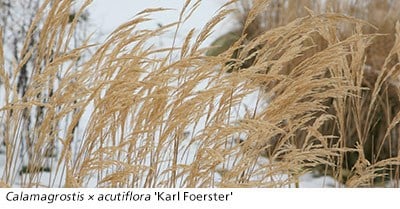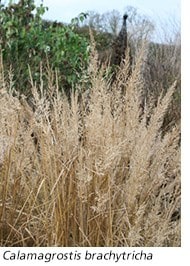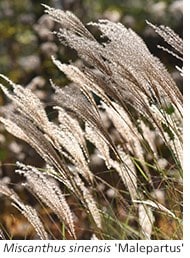Shimmering late-season grasses

 With the garden devoid of summer froth and carpeted in autumn leaves, certain plants shine at this time of year, a well-placed grass shimmering against a winter sunset, or the reddish brown, silky feathers shimmering in low sunlight are winter treats.
With the garden devoid of summer froth and carpeted in autumn leaves, certain plants shine at this time of year, a well-placed grass shimmering against a winter sunset, or the reddish brown, silky feathers shimmering in low sunlight are winter treats.
You don’t have to strain your eyes to spot tall grasses. They lord it above the garden in winter, moving and swaying and catching low light. And yet gardeners are reticent, afraid that grasses will roam through their borders or set lots of seeds. In our cooler climate most grasses do not set seed and good grasses are clump formers, not running invaders. Perhaps the thuggish reputation of the striped grass, gardener’s garters (Phalaris arundinacea var. picta) has put them off forever.
It’s taller grasses that make most impact now and Miscanthus sinensis ‘Malepartus’ is a graceful light grass that allows the sun to shine through its veil of gossamer heads. ‘Malepartus’ is an early bloomer (from mid-August onwards) with finely-tined reddish awns that develop into mink-brown within two weeks. It’s airier than most - and will reach 2m. ‘Kleine Fontane’ (literally little fountain) and ‘Kleine Silberspinne’ (little silver spider) are both shorter forms at 1.5m and 1.2m respectively. ‘Kleine Fontane’ opens pink and fades to silver and ‘Kleine Silberspinne’ opens silvery. These forms bear plenty of flower.
 Miscanthus sinensis are hardy and easy on reasonable soil that is not too dry. They will keep their shape until late-January at least, but they're best cut down soon afterwards because they break into growth early in the year producing lush new foliage - usually by April. This bright young foliage can make an excellent backdrop for tulips. Cut miscanthus back too late and you’ll be cutting into the new growth.
Miscanthus sinensis are hardy and easy on reasonable soil that is not too dry. They will keep their shape until late-January at least, but they're best cut down soon afterwards because they break into growth early in the year producing lush new foliage - usually by April. This bright young foliage can make an excellent backdrop for tulips. Cut miscanthus back too late and you’ll be cutting into the new growth.
If you succeed with miscanthus you will also be able to grow the taller version of the purple moor grass - Molinia caerulea subsp.arundinacea. The last part of the Latin name refers to the tall grass Arundo, so look for this rather than the shorter statured M. caerulea subsp. caerulea ‘Poul Petersen’, named after a Dutch nurseryman, forms a neat clump of green foliage and the long stems and flower heads are purple-tinted before fading into winter. Those long stems really move and flow in wind to great effect, like all tall molinias, caressing the remains of tall-late-season perennials. ‘Transparent’ is a black-beaded fine form that looks wonderful after a winter squall.
If you want to create a rigid upright, the best grass is Calamagrostis x acutiflora ‘Karl Foerster’. This shoulder-high grass packs in lots of stems topped by tapering upright grassy heads. These appear in summer and, as autumn and winter arrive, the sheath of stems turns russet-red. Pampas grasses, Cortaderia, are also very upright in form, and far too good for bungalow lawns. They add great winter presence and stand out well late in the year with the wine-red lollipops of Cotinus coggygria, the smoke bush. This deciduous shrub loses its leaves late on, developing flecks of bright-pink in cold conditions. Cortaderia selloana ‘Pumila’ is a relatively short and more compact plant, so ideal where space is limited.
If you prefer fluffy caterpillars at the front of the border opt for
Pennisetum alopecuroides ‘Hameln', a much hardier form with browner fuzzy bear caterpillars topping a roundel of foliage. These will persist throughout winter.






